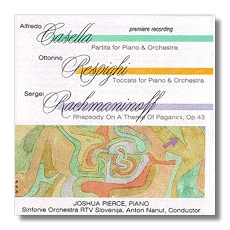
Rachmaninoff, Sergei
Sergei Vassileivitch Rachmaninoff was born on April 2, 1873 at Oneg, Novgorod, Russia. He died in Beverly Hills, California, March 28, 1943. All during his life, and for many decades after his passing, Sergei Rachmaninoff was regarded as – at best – an anomoly, a throwback to the 19th century, as his music always expressed itself through an unabashedly Romantic language: At times haunting, morose and forboding; at others, gentle, passionate and con molte dolce. But always, all these conflicting pathos would recede as the finales of his greatest works – such as the Symphony No. 2, the Rhapsody on a Theme of Paganini and the valedictory Symphonic Dances – would give way to beautiful resolutions of triumph.
If listening to Rachamaninoff seemed to some a futile exercise in depression and an exploration of the depths of sorrow, this was because of the complexity of the composer himself. Almost all of Rachmaninoff’s major works were undergirded by the Roman Catholic Dies Irae. But that was only half of the story; for the listener will have found himself transported from the inevitability of death, to rise above the despair and exalt in the life-affirming, powerful finales for which the composer was so well-known. Only in Die Toteninsel (after Arnold Boecklin’s painting) is death the final arbiter.
To hear Rachmaninoff’s music is to understand the soul of the composer himself. While composing, he literally poured himself into his compositions. After his Symphony No. 1 had a disastrous premiere in Moscow in 1897, Rachmaninoff was so severely depressed, that he sought treatment from hypnotist Dr. Nikolai Dahl. Dr. Dahl repeated, like a mantra, to the forlorn composer, “you will began to write your concerto….you will work with great facility….the concerto will be of an excellent quality….” The results of these sessions with Dr. Dahl was the emergence of the composer from the throes of depression, and also, perhaps, his most straightforward and beautiful work, the Second Piano Concerto in C-Minor, Op. 18. And yet, the second movement, adagio sostenuto – although a tender, impassioned liebeslied – eloquently exhibits the composer’s sense of wistfulness and melancholy he was never fully able to overcome.
Listen to any of Rachmaninoff’s great works: At once they are transcendent and yet so personally private. Rachmaninoff’s style of composition grew out of the Romantic period of the late-19th century, in the tradition begun by Mendelssohn, Schumann and Liszt, as carried on by Brahms, Dvorak and Rachmaninoff’s own teacher and mentor, Tchaikovsky. Like Tchaikovsky, Rachmaninoff wrote music that was thoroughly Russian, and thoroughly infused with so many of the emotional conflicts and yearnings ingrained in both composers .
The Great War and the Bolshevik Revolution had left Europe ravaged, and during this period, Rachmaninoff was one of the many musicians who became an expatriate of his own land, never to return to the Russia he had so loved. But something else had happened in the previous decade: New musical idioms had come to the fore. Some composers, such as Sibelius, Vaughan Williams and Elgar, had transformed the language of Romantic music into the distinctly twentieth-century “neo-romantic” sound, which combined traditional musical modes of expression with experimentation in orchestration and theme. In France, taking the lead of earlier Romantics as Saint-Saens, Impressionists such as Debussy and Ravel “painted pictures in sound.” The previous decade had also seen the increasing popularity of such “modernistic” composers as Stravinsky, Schoenberg and Bartok, who employed a new radicalism in sound, exploring the limits of atonality and polytonality. Most representative of this new way of composing was Stravinsky’s Le Sacre du Printemps, which – upon its Paris premiere in 1913 – started a riot right in the concert hall.
Yet, against the changing tide, Rachmaninoff stood immobile. Not as a matter of principle, but because he knew his own direction and simply followed it. Certainly, no-one could say there was no “growth” or maturity between Rachmaninoff’s 1st Piano Concerto (1891) and his Fourth (1924), but the progress in Rachmaninoff’s musical expression was measured. Mind you, Rachmaninoff’s 1st Concerto was the product of an 18 year-old already accomplished in the art of musical composition. Nevertheless, Rachmaninoff lived to see his music routinely sneered at and panned by the alleged representatives of musical “taste,” the critics. He was smeared as a 19th century atavist, who composed insignificant “virtuoso” pieces that were just fine for showing off a pianist’s technical skill, but were thematically “mechanistic,” and steeped in “shallow,” “overemotional” bathos.
Indeed, it is quite ironic that Rachmaninoff – a Russian noble who admired the Czar and chose exile, rather than to live under the Soviets – so hated and ignored by the critics, was a perennial favourite of the public. Rachmaninoff’s concerts always sold out, and his pieces always brought performers and orchestras large audiences when programmed.
Sergei Rachmaninoff died in 1943 in Beverly Hills, California. During his own lifetime, he was widely respected and feted as one of the greatest conductors and concert pianists of all time. Yet, his secret dream – to be remembered for his compositions – seemed fleeting and futile. But, as is the cases with many geniuses, in the decades after his death, Rachmaninoff’s reputation grew as an innovative composer, principally through the efforts of his admirers, such as Eugene Ormandy, Leopold Stokowski, Vladimir Horowitz, Dmitri Mitropoulos, Artur Rubinstein, Ruth Laredo, Vladimir Ashkenazy and Andre Previn, among countless others. Year after year, his recordings carried to those who would just listen with their own ears the fact that here was not a hopelessly obsolete second-rate throwback to the 19th century, but indeed a man ahead of his time, who communicated his deepest-held emotions honestly, beautifully and forcefully, rather than sell out his soul to “keep up with the times.”
